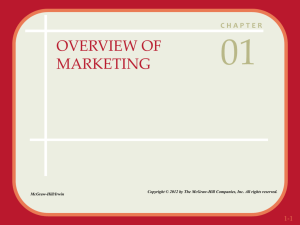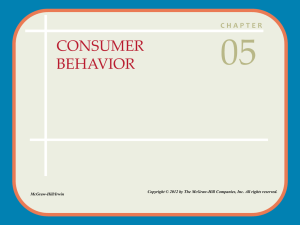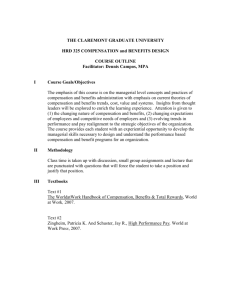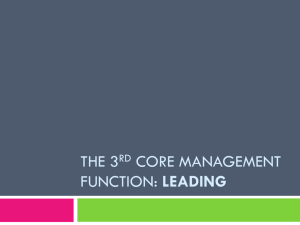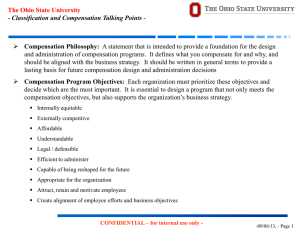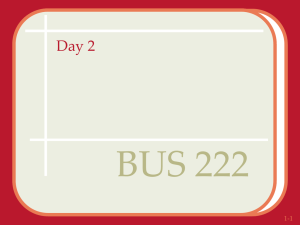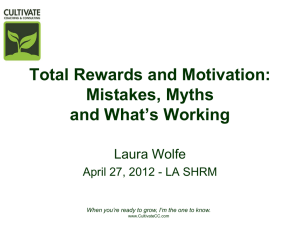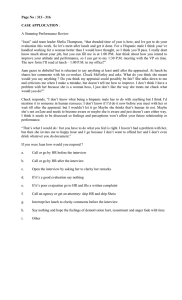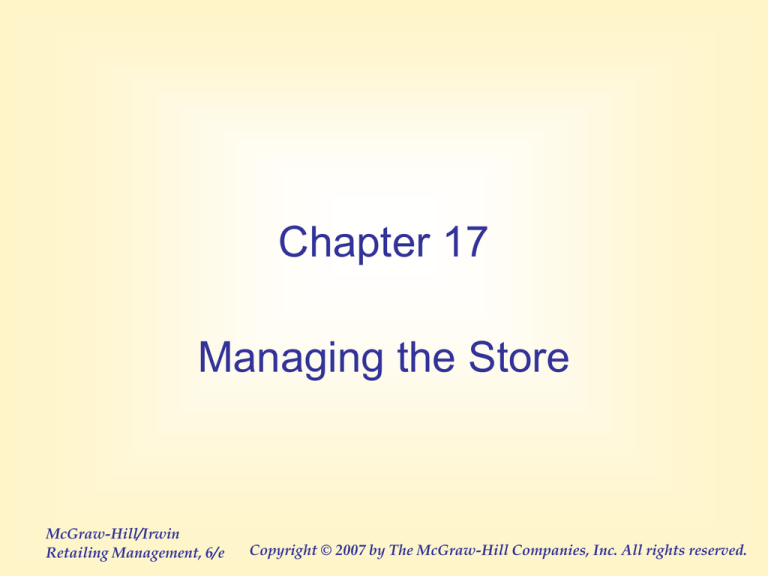
Chapter 17
Managing the Store
McGraw-Hill/Irwin
Retailing Management, 6/e
Copyright © 2007 by The McGraw-Hill Companies, Inc. All rights reserved.
17-2
Store Management
Customer Service
Layout, Design and
Visual Merchandising
Managing the Store
17-3
Store Managers Run a Business
“This is your business. Do your own thing.
Don’t listen to us in Seattle, listen to your
customers. We give you permission to take
care of your customers.”
James Nordstrom, the CEO of Nordstrom’s
17-4
Strategic Importance of Store Management
Opportunity to Build Strategic Advantage
– Difficult to Have Unique, Compelling
Merchandise
– Customer Loyalty Often Based on Customer
Service
Difficulty of Store Managers Job
– Managing Diverse Set of Unskilled People
– Increasing Empowerment and Responsibility
to Tailor Merchandise and Presentation to
Local Community
17-5
Store Managers’ Responsibilities
Varies Dramatically By Type of Retailers
– Specialty Store vs. Department Store
Entrepreneur
– P & L Responsibility
– Manage People
© Digital Vision
Responsible for Two Critical Assets
– People Sales/Employees
– Space Sales/Square Foot
Steps in Employment
Management Process
17-6
17-7
Job Analysis
17-8
Job Description
A guideline for recruiting, selecting,
training and evaluating employees
The activities the
employee needs to
perform
The performance
expectations
expressed in
quantitative terms
Steve Mason/Getty Images
17-9
Approaches for Locating Prospective Employees
• Look beyond the retail
industry
• Use your employees as
talent scouts
• Provide incentives for
employee referrals
• Recruit minorities,
immigrants and older workers
• Use your storefront creatively
Jack Star/PhotoLink/Getty Images
17-10
Sources of Information for
Screening Applicants
•
•
•
•
Application Forms
References
Testing
Providing a Realistic
Job Preview
The McGraw-Hill Companies,
Inc./Lars A. Niki, photographer
17-11
Suggestions for Questioning Applicant
• Avoid asking questions that have multiple parts
• Avoid asking leading questions like “Are you prepared to
provide good customer service?”
• Be an active listener. Evaluate the information being
presented and sort out the important comments from the
unimportant.
repeat or rephrase information
summarize the conversation
tolerate silence
Legal Considerations in Hiring
and Selecting Employees
17-12
• Equal Employment Opportunity Commission
(EEOC)
• Age Discrimination and Employment Act
– Disparate Treatment
– Disparate Impact
• Americans with Disabilities Act (ADA)
17-13
Socializing and Training Employees
Orientation Program
Training
-Where, when, what
-Structured vs. unstructured
-Classroom vs. on-the-job
(c) image100/PunchStock
-Analyzing Successes and Failures
17-14
Motivating and Managing Employees
Setting
Goals
Providing
Incentives
to Achieve
Goals
Providing
Feedback
Measuring
Performance
17-15
Leadership
Process by which one person attempts to
influence another to accomplish some goal
or goals
Leader Behaviors
– Task-Oriented
– Group Maintenance
C Squared Studios/Getty Images
17-16
Types of Leaders
Autocratic
Democratic
Transformational
© Digital Vision
Which Type of Leader Is the Most Effective?
17-17
Setting Goals
How High?
How Easy
to Achieve?
Get Participation of
Employees in
Setting Goals
Royalty-Free/CORBIS
17-18
Why Set Goals?
Employee performance improves when
employees feel:
• That their efforts will enable them to
achieve the goals set for them by
their managers
• That they’ll receive rewards they
value if they achieve their goals
Royalty-Free/CORBIS
17-19
Individualized Motivation Programs
Impact of Goals Differs Across
People
Different People Seek Differ
Rewards
– A La Carte Reward Programs
– Selection of Compensation
Plans
Steve Cole/Getty Images
17-20
Maintaining Morale
Meetings before store opening to talk about new
merchandise and hear employee opinions
Educate, set sales goals and have a pizza party
when goals are met
Divide charity budget and ask employees how
their share should be used
Print stickers - auto detailed by Rob”
Pando Hall / Getty Images
Give every employee a business card with the
company mission statement printed on the back
17-21
Evaluating and Providing
Feedback to Employees
Evaluation
- Who, when, how often?
Feedback
- Performance outcome vs. process
17-22
Jim Taylor’s Six Month Evaluation
17-23
Common Evaluation Errors
Strickness
Ratings unduly negative
Leniency
Rating unduly positive
Haloing
Using the same rating on all aspects of the
evaluation
Recency
Placing too much weight on recent events rather
than evaluating performance over the entire
period
Contrast
Having the evaluation of a salesperson unduly
influenced by the evaluation of other salespeople
Attributions
Making errors in identifying causes of the
salesperson’s performance
17-24
Rewards
• Extrinsic Rewards are rewards provided by
either the employee’s manager or the firm such
as compensation, promotion and recognition.
• Intrinsic Rewards are rewards employees get
personally from doing their job well like doing
their job well because they think it is challenging
and fun
17-25
Compensating Employees
Compensation
- Type
• Straight salary
•
Straight commission
• Quota bonus
- Setting quotas
- Individual vs. group incentives
Royalty-Free/CORBIS
Advantages and Disadvantages
of Straight Salary
Straight Salary
Incentive Compensation
Offers flexibility in assigning employees
to activities
Has high motivating potential
Builds stronger employee commitment
Has more variable cost
Is easy for employees to understand
Relates compensation to productivity
Is easy to administer
Allows for better performance of
non-selling activities such as customer
service
17-26
17-27
Designing a Compensation Plan
Determine
Appropriate
Compensation
$12/Hour
Decide on
Percent of
Incentives
1/3 Salary
2/3 Incentive
Use Average
Sales Per
Employee to
Set Incentive
Rate
Sales/Person - $150
5.33% Commission
$4/Hour Salary
$4 = 5.33% x 150 = $12
17-28
Controlling Costs
Energy
Heating
Lighting
Labor
Costs Controlled by
Store Managers
Maintenance
Inventory
Shrinkage
17-29
Labor Scheduling System
17-30
Calculating Shrinkage
Accounting Record – Actual Inventory
Sales
$1,500,000 - $1,236,00
$4,225,000
=
6.7%
17-31
Sources of Inventory Shrinkage
Shoplifting 31%
Mistakes and
Inaccurate
Records 17%
Vendor Errors 6%
Employee Theft 46%
17-32
Preventing Shoplifting
Store design
Employee training
Good customer service
- Security measures
- Dye capsules, TV cameras
- EAS
Prosecution
PhotoLink/Getty Images
17-33
Spotting Shoplifters
17-34
Use of Security Measures by Retailers
17-35
EAS Tags
17-36
Reducing Employee Theft
Trusting, supportive work atmosphere
Employee screening
- Honesty, drug testing
Security personnel - mystery shoppers
Policies and procedures
Employee theft is an HR problem.


